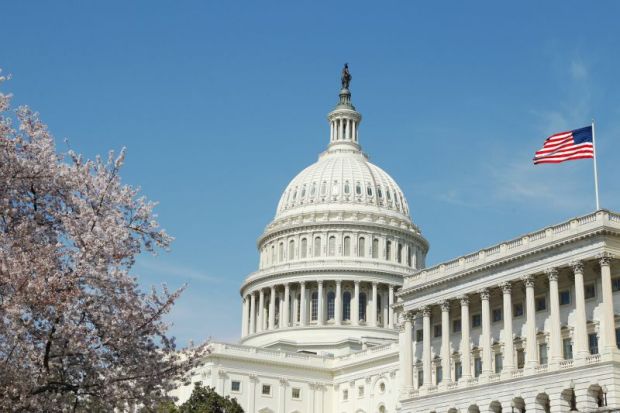It’s been years since the US Congress – even with same-party control – has seriously considered passing anything resembling the presidential budget request.
It’s a reflection of politics infesting all aspects of sober governing – presidents proposing extremes on spending or tax cuts, thereby fulfilling campaign promises, while leaving lawmakers to bring things back to reality.
The fiscal 2020 budget put forth by President Trump – seeking deep spending cuts for student aid and university research – is another wild extension of that approach.
That’s the good news for higher education: While Mr Trump offers grist for his conservative admirers, Republican-led Congresses have rejected them the past two years. Now Democrats control the House, bringing an even greater determination to push back.
There is some bad news, however, and it’s both complicated and simple.
The simple part is contained in two huge numbers: the nation has an accumulated public debt of $22 trillion (£16.7 trillion), with growing federal budget deficits now adding some $900 billion (£681 billion) to that annually.
The complicated part is something known as Discretionary Caps. The caps arose in the 2011 budget battle, when Republicans controlling the House, warning about the danger of budget deficits, refused the perfunctory step of raising the nation’s legal borrowing limit.
Congress settled that dispute by requiring that all “discretionary” spending – non-legal entitlements such as medicare and social security programs that overwhelmingly drive federal budget deficits – be split equally between defence and non-defence programmes for the next 10 years.
The result is a major procedural hurdle on top of a worsening budgetary reality. If Congress obeys its Discretionary Caps, both defence and non-defence discretionary spending would need to be cut by more than 10 per cent in 2020.
That’s not likely to happen. Since the 2011 showdown, Congress has repeatedly approved short-term exceptions to override those caps rather than address the entitlements problem, and both parties are already looking for another circumvention.
Congressional Democrats are urging a relatively straight override, while the Trump budget seeks a de facto method, proposing that billions of dollars in war-related spending simply be counted outside the caps.
That sets up another year in which lawmakers will need to choose between their stated commitment to fiscal sobriety and their desire to please voters who want better education options for their children and communities.
That is a trade-off that has generally ended well for colleges and their students so far in the Trump administration. Over the past two years, the national debt has grown by $2 trillion (£1.5 trillion), while the maximum individual award under the Pell Grant program for low-income students has risen $275 to $6,195 (£4,688), federal support for Hispanic-serving and historically black colleges has risen 10 per cent or more, and the budget of the National Institutes of Health, the leading supplier of basic research money for US universities, has grown by $5 billion (£3.8 billion).
Mr Trump, by comparison, would cut Pell by $2 billion (£1.5 billion), the NIH by $5 billion, and overall Department of Education funding by $8.5 billion.
But, Republicans show far less ideological commitment to avoiding budget deficits than they have shown in the past, and the traditional Republican emphasis on military spending continues to lose allies – two factors that bode well for robust education spending, and the deficits, to continue.
Just last month, a group of nearly 350 retired US admirals and generals wrote to Congress urging lawmakers to reconsider the budget caps to provide more money to education. The military chiefs described educational quality as a growing priority for the military, which is falling behind on its recruiting goals.
“We are deeply concerned that 71 per cent of young Americans aged 17 to 24 cannot qualify for military service because they are too poorly educated, medically or physically unfit, or have a disqualifying record of crime or drug abuse,” the admirals and generals said.
If congressional Republicans do choose to stick with the administration, they have a powerful tool awaiting them: under current projections, the federal government has enough legal authority to spend money until about September. At that point, Congress will again need to approve an increase in the debt limit – or perhaps pursue a repeat of the 2011 budget showdown.
But even Mr Trump’s Secretary of Education, Betsy DeVos, admitted that Congress might not need to take the administration’s budgetary numbers literally. “Budgets are about priorities,” Ms. DeVos told lawmakers at an initial budget hearing on 26 March on Capitol Hill. “Remember, they are just proposals to you.”
Paul Basken in North America editor for Times Higher Education. He is based in Washington DC.
Register to continue
Why register?
- Registration is free and only takes a moment
- Once registered, you can read 3 articles a month
- Sign up for our newsletter
Subscribe
Or subscribe for unlimited access to:
- Unlimited access to news, views, insights & reviews
- Digital editions
- Digital access to THE’s university and college rankings analysis
Already registered or a current subscriber? Login


